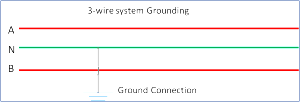Grounding and bonding theory Quiz -1
Free online test on Grounding and bonding ( National Electrical Code – 250)
Grounding and Bonding :
Grounding of an electrical system should be done to limit high voltage causes by lighting strikes or any miss-contact of low voltage wires with high voltage wires. This is categorized into two categories:
System Grounding :
 This refers grounding one ore more current carrying hot conductors of the electrical system installation.
This refers grounding one ore more current carrying hot conductors of the electrical system installation.
Equipment Grounding:
This refers grounding non current carrying parts of the electrical installation such as service equipment cabinet, the frames of an electric motor.
Important Notes :
- The grounded wire is never interrupted by a circuit breaker, fuse or any other device unless the device used is so designated that in opening the grounding conductor opens all other ungrounded conductors at the same time.
- As per the Code the grounded wire to be identified by a white or natural grey finish through out its length.
- As per code all receptacles 15 and 20 amp circuits, at 120 volts should be of grounding type.
- The voltage to ground is the maximum voltage that exists between ground wire and any hot wire in the circuit.
GFCI (Ground Fault Circuit Interceptor):
GFCI will be used to sense the difference between two wires, and if the fault current increases the trip level of GFCI, it will opens the circuit with in no time.
1) In dwelling units on all 15 and 20 amp outdoor receptacles on all bathroom and garage receptacles should be fitted with GFCI protection.
2) GFCI protection should be provided in construction site 15 and 20 amp receptacles which are not part of the permanent wiring of the building or structure.